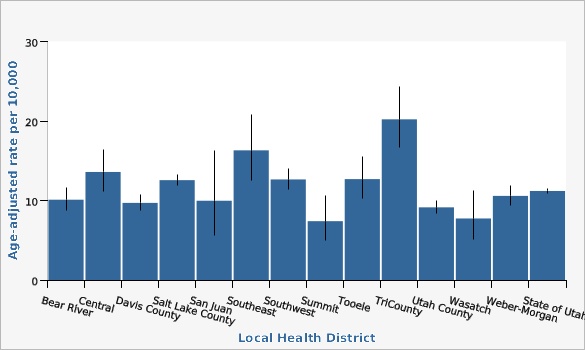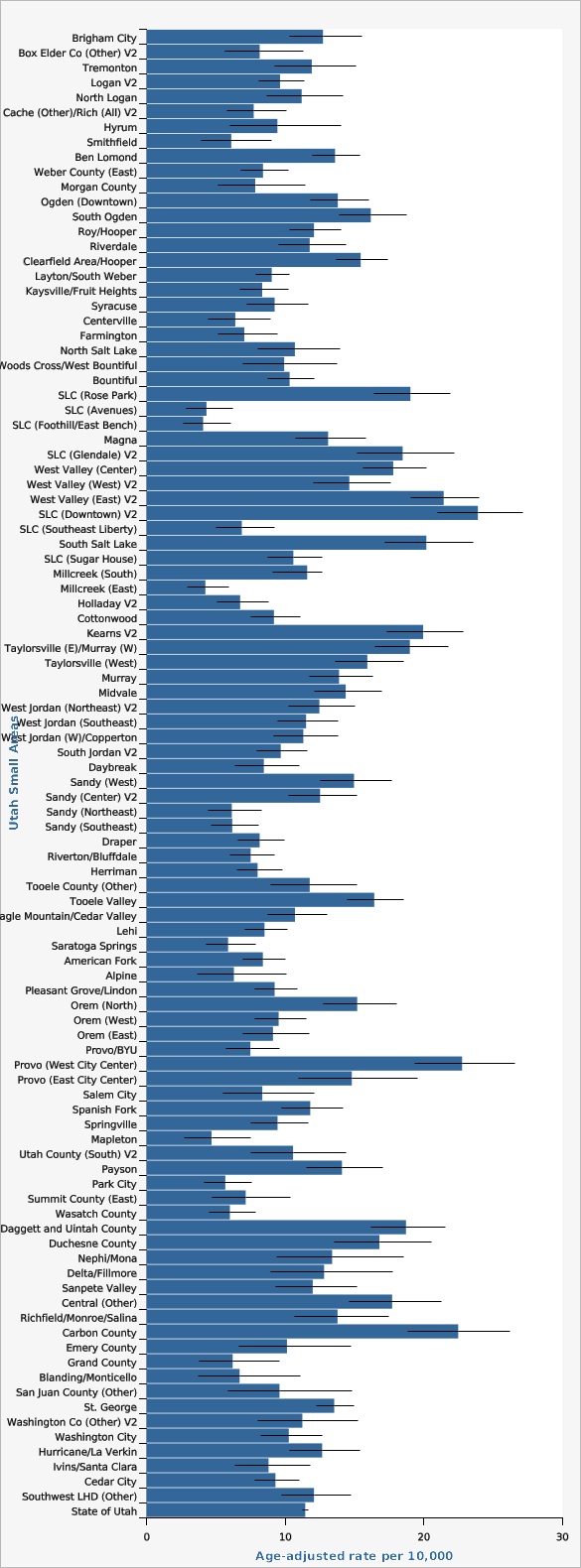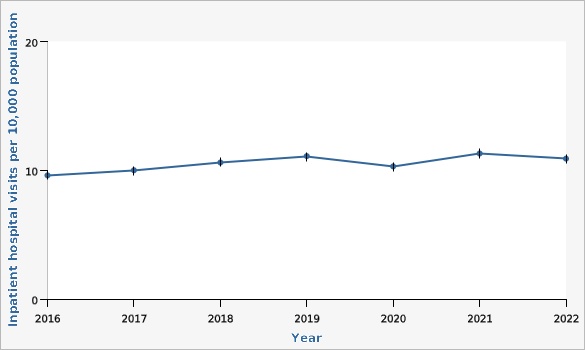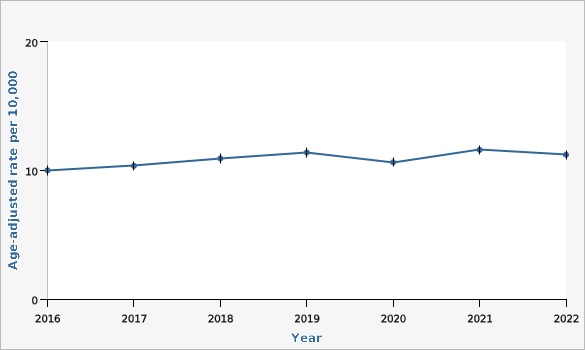Complete Health Indicator Report of Diabetes as Primary Diagnosis for Hospitalization
Definition
Inpatient hospital discharges with an ICD-10 code as the primary diagnosis that ranges between E10-E14. ICD-10-CM/PCS code sets took effect on October 1, 2015. Prior to October 1, 2015 the follow ICD-9 codes were used as the primary diagnosis 250.0-250.9.Numerator
Number of hospital discharges listing diabetes as the primary diagnosis.Denominator
All Utah residents.Data Interpretation Issues
Hospital records may contain up to 10 diagnosis codes. The first listed diagnosis is generally considered the primary reason for the hospitalization.Why Is This Important?
Diabetes is an enormous burden on the healthcare system. The direct and indirect costs of diabetes nationally are estimated to be at least $413 billion per year. (Centers for Disease Control and Prevention: Diabetes Fast Facts, 2023 [https://www.cdc.gov/diabetes/basics/quick-facts.html]).How Are We Doing?
The crude rate of hospital discharges listing diabetes as the primary diagnosis per 10,000 Utah population has been fairly consistent during the past 5 years, between 9 and 12 discharges per 10,000 population. In 2022 the crude rate was 10.9 (10.5-11.2) diabetes discharges per 10,000 population.How Do We Compare With the U.S.?
Rates of hospitalization for discharges listing diabetes as the primary diagnosis for the U.S. are substantially higher than those for Utah. The overall rate of hospital discharges with diabetes as the primary diagnosis was 33.5 per 10,000 population for the U.S in 2020. ([https://www.cdc.gov/diabetes/data/statistics-report/index.html]).What Is Being Done?
The Healthy Environments Active Living (HEAL) program encourages people with diabetes to enroll in a [https://heal.utah.gov/dsmes/ diabetes self-management education class]. These classes have been shown to help individuals develop the skills they need to manage their diabetes and are usually taught by dietitians, nurses, or pharmacists, who may also hold the status of Certified Diabetes Educator (CDE). CDEs have considerable expertise in diabetes management and understand what the individual with diabetes is going through. The Utah Healthy Aging Program supports Chronic Disease Self-Management Programs and Diabetes Self-Management Programs throughout the state, this program is also called the Living Well with Chronic Conditions Program. This six-week program is available throughout the state at no cost and taught by community members. Information is available from Nichole Shepard, 385-315-2000, nshepard@utah.gov. More information is available on the [https://healthyaging.utah.gov/livingwell/ Healthy Aging Program website]. The HEAL program is working statewide to increase the number of locations that offer Diabetes Self-Management Education (DSME) and also promote DSME to eligible participants. The National Diabetes Prevention Program (National DPP) is also an evidence-based program to prevent type 2 diabetes. The HEAL program works with statewide partners to promote the National DPP to eligible Utahns and also is working to expand National DPP sites across the state.Evidence-based Practices
Diabetes Self-Management Classes have been shown to improve blood sugar control among participants. In Utah, programs are available that are recognized by the American Diabetes Association or certified by the American Association of Diabetes Educators. Information on classes in Utah is available on the [https://heal.utah.gov/dsmes/ HEAL website].Available Services
The American Diabetes Association (ADA) is an excellent resource for all types of information on diabetes. Call 1-800-DIABETES or visit their [http://www.diabetes.org website]. [https://www.niddk.nih.gov/health-information/communication-programs/ndep The National Diabetes Education Program] has resources for diabetes management for professionals, businesses, and patients. Most materials are available upon request at no charge. [https://www.cdc.gov/diabetes/prevention/index.html The National Diabetes Prevention Program] has resources for diabetes prevention for employers, insurers, health care professionals, program providers, and individuals. [https://dhhs.utah.gov/ The Utah Department of Health and Human Services] has a Health Resource hotline: 1-888-222-2542. Please call this number for information about self-management programs in Utah. The Healthy Environments Active Living (HEAL) Program website provides information on [https://heal.utah.gov/dsmes/ diabetes self-management classes]. [https://www.adces.org/ Association of Diabetes Care & Education Specialists][[br]] 800-338-3633[[br]] Local Chapter Facebook Page: [https://www.facebook.com/UtahADCES/] [http://www.heart.org American Heart Association][[br]] 1937 S. 300 W. #120[[br]] Salt Lake City, UT 84115[[br]] (801) 484-3838 or[[br]] 1-800-242-8721Health Program Information
The Utah Department of Health and Human Services Resource Line can provide information about enrolling in diabetes self-management classes. Call 1-888-222-2542 for more information. The Utah Department of Health and Human Services, Healthy Environments Active Living program plays a key role in improving the health of residents in the state of Utah. The program was formed in July 2013 (as EPICC), through a new funding opportunity from the Centers of Disease Control and Prevention (CDC) that allowed for the merging of three previously existing programs: the Heart Disease and Stroke Prevention Program, the Diabetes Prevention and Control Program, and the Physical Activity, Nutrition and Obesity Program, as well as the addition of a school health program. The Healthy Environments Active Living Program (HEAL) was recently restructured as part of this strategic planning process and the new program model focuses on working together with staff and partners to address the social determinants of health while advancing health equity and increasing policy, systems and environment changes. HEAL champions public health initiatives and addresses the challenges of making health awareness and access truly universal and equitable in eight key areas: nutrition, heart health, diabetes, physical activity, schools, child care, community health workers, and worksites. Visit [https://heal.utah.gov/ HEAL's website] for more information.Related Indicators
Relevant Population Characteristics
Individuals with diabetes have higher rates of hospitalization than those without diabetes across every age group. The most common reason for hospitalization among youth with diabetes is ketoacidosis. Older individuals are most likely to be hospitalized for diabetes-related cardiovascular problems.Related Relevant Population Characteristics Indicators:
- Utah Population Characteristics: Age Distribution of the Population
- Utah Population Characteristics: Poverty, Children Age 17 and Under
- Cost as a Barrier to Health Care
- Disability Prevalence
- Utah Population Characteristics: Education Level in the Population
- Fair/poor Health
- Utah Population Characteristics: Household Income
- Utah Population Characteristics: Household Structure
- Utah Health Improvement Index (HII)
- No Health Insurance Coverage
- Utah Population Characteristics: Poverty, All Persons
- Utah Population Characteristics: Racial and Ethnic Composition of the Population
- Utah Population Characteristics: Historical Population Estimates
Health Care System Factors
In 2022 there were 3,699 discharges from Utah hospitals listing diabetes as the primary diagnosis. The average charge for a hospital discharge with diabetes as the primary diagnosis was $35,046.47 (with a median charge of $21,732.19). People with diabetes are hospitalized for both acute and chronic complications. Many hospitalizations due to diabetes could be prevented if sufficient outpatient and self-management care is available, accessible, and obtained.Related Health Care System Factors Indicators:
Risk Factors
Many hospitalizations related to diabetes may be avoided with proper self-management and regular, routine physician visits. One of the most preventable causes of hospitalization is ketoacidosis. It is, nevertheless, the leading cause of hospitalization among youth with diabetes.Related Risk Factors Indicators:
Health Status Outcomes
Individuals with diabetes should make special efforts to seek good health. Behavioral measures, such as having an adequate amount of physical activity, eating a nutritious diet, and maintaining a healthy weight can substantially lower the risk of hospitalization.Related Health Status Outcomes Indicators:
Graphical Data Views
Hospitalizations with diabetes as the primary diagnosis (crude rates) by Utah local health district, 2022
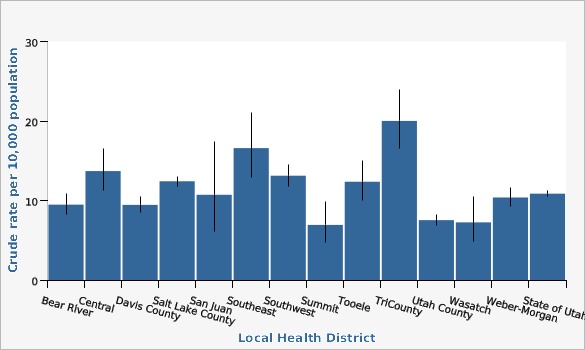
Rates of hospitalization with diabetes as the primary diagnosis at the local health department level ranged from 6.9 to 20.0 per 10,000 patients.
| Local Health District | Crude rate per 10,000 population | Lower Limit | Upper Limit | |||
|---|---|---|---|---|---|---|
Record Count: 14 | ||||||
| Bear River | 9.5 | 8.2 | 10.9 | |||
| Central | 13.7 | 11.3 | 16.5 | |||
| Davis County | 9.4 | 8.5 | 10.5 | |||
| Salt Lake County | 12.4 | 11.8 | 13.1 | |||
| San Juan | 10.7 | 6.1 | 17.4 | |||
| Southeast | 16.6 | 12.9 | 21.1 | |||
| Southwest | 13.1 | 11.8 | 14.5 | |||
| Summit | 6.9 | 4.7 | 9.9 | |||
| Tooele | 12.4 | 10.0 | 15.1 | |||
| TriCounty | 20.0 | 16.5 | 24.0 | |||
| Utah County | 7.5 | 6.9 | 8.2 | |||
| Wasatch | 7.2 | 4.8 | 10.6 | |||
| Weber-Morgan | 10.4 | 9.2 | 11.6 | |||
| State of Utah | 10.9 | 10.5 | 11.2 | |||
Data Notes
ICD-10 codes E10-E14.Data Sources
- Utah Inpatient Hospital Discharge Data, Healthcare Information & Analysis Programs, Office of Research & Evaluation, Utah Department of Health and Human Services
- For years 2020 and later, the population estimates are provided by the Kem C. Gardner Policy Institute, Utah state and county annual population estimates are by single year of age and sex, IBIS Version 2022
More rural and frontier local health districts have higher age-adjusted rates of hospitalizations due to diabetes.
| Local Health District | Age-adjusted rate per 10,000 | Lower Limit | Upper Limit | |||
|---|---|---|---|---|---|---|
Record Count: 14 | ||||||
| Bear River | 10.1 | 8.7 | 11.7 | |||
| Central | 13.6 | 11.1 | 16.4 | |||
| Davis County | 9.7 | 8.7 | 10.8 | |||
| Salt Lake County | 12.6 | 11.9 | 13.2 | |||
| San Juan | 10.0 | 5.6 | 16.3 | |||
| Southeast | 16.3 | 12.6 | 20.8 | |||
| Southwest | 12.6 | 11.3 | 14.1 | |||
| Summit | 7.4 | 4.9 | 10.7 | |||
| Tooele | 12.7 | 10.2 | 15.6 | |||
| TriCounty | 20.2 | 16.6 | 24.3 | |||
| Utah County | 9.1 | 8.4 | 10.0 | |||
| Wasatch | 7.7 | 5.1 | 11.3 | |||
| Weber-Morgan | 10.6 | 9.4 | 11.9 | |||
| State of Utah | 11.2 | 10.8 | 11.6 | |||
Data Notes
ICD-10 codes E10-E14. Age-adjusted to the U.S. 2000 standard population.Data Sources
- Utah Inpatient Hospital Discharge Data, Healthcare Information & Analysis Programs, Office of Research & Evaluation, Utah Department of Health and Human Services
- For years 2020 and later, the population estimates are provided by the Kem C. Gardner Policy Institute, Utah state and county annual population estimates are by single year of age and sex, IBIS Version 2022
The top 3 small areas that have the highest age-adjusted rates of diabetes hospital discharge are: Salt Lake City (Downtown) V2 (23.9), Carbon County (22.5), and Provo (West City Center; 22.8).
| Utah Small Areas | Age-adjusted rate per 10,000 | Lower Limit | Upper Limit | |||
|---|---|---|---|---|---|---|
Record Count: 100 | ||||||
| Brigham City | 12.7 | 10.3 | 15.6 | |||
| Box Elder Co (Other) V2 | 8.2 | 5.7 | 11.4 | |||
| Tremonton | 11.9 | 9.2 | 15.2 | |||
| Logan V2 | 9.6 | 8.1 | 11.4 | |||
| North Logan | 11.2 | 8.7 | 14.2 | |||
| Cache (Other)/Rich (All) V2 | 7.7 | 5.8 | 10.1 | |||
| Hyrum | 9.4 | 6.0 | 14.1 | |||
| Smithfield | 6.1 | 3.9 | 9.1 | |||
| Ben Lomond | 13.6 | 12.0 | 15.4 | |||
| Weber County (East) | 8.4 | 6.8 | 10.3 | |||
| Morgan County | 7.8 | 5.2 | 11.4 | |||
| Ogden (Downtown) | 13.8 | 11.8 | 16.0 | |||
| South Ogden | 16.2 | 13.9 | 18.8 | |||
| Roy/Hooper | 12.1 | 10.3 | 14.1 | |||
| Riverdale | 11.8 | 9.5 | 14.4 | |||
| Clearfield Area/Hooper | 15.5 | 13.7 | 17.4 | |||
| Layton/South Weber | 9.0 | 7.9 | 10.3 | |||
| Kaysville/Fruit Heights | 8.4 | 6.7 | 10.2 | |||
| Syracuse | 9.2 | 7.2 | 11.7 | |||
| Centerville | 6.4 | 4.4 | 9.0 | |||
| Farmington | 7.1 | 5.2 | 9.4 | |||
| North Salt Lake | 10.7 | 8.0 | 14.0 | |||
| Woods Cross/West Bountiful | 9.9 | 7.0 | 13.8 | |||
| Bountiful | 10.3 | 8.7 | 12.1 | |||
| SLC (Rose Park) | 19.0 | 16.4 | 22.0 | |||
| SLC (Avenues) | 4.3 | 2.9 | 6.3 | |||
| SLC (Foothill/East Bench) | 4.1 | 2.6 | 6.1 | |||
| Magna | 13.1 | 10.8 | 15.8 | |||
| SLC (Glendale) V2 | 18.5 | 15.2 | 22.2 | |||
| West Valley (Center) | 17.8 | 15.7 | 20.2 | |||
| West Valley (West) V2 | 14.6 | 12.0 | 17.7 | |||
| West Valley (East) V2 | 21.4 | 19.1 | 24.0 | |||
| SLC (Downtown) V2 | 23.9 | 21.0 | 27.2 | |||
| SLC (Southeast Liberty) | 6.9 | 5.0 | 9.2 | |||
| South Salt Lake | 20.2 | 17.2 | 23.6 | |||
| SLC (Sugar House) | 10.6 | 8.8 | 12.7 | |||
| Millcreek (South) | 11.6 | 9.1 | 12.7 | |||
| Millcreek (East) | 4.2 | 2.9 | 6.0 | |||
| Holladay V2 | 6.8 | 5.1 | 8.8 | |||
| Cottonwood | 9.2 | 7.6 | 11.1 | |||
| Kearns V2 | 20.0 | 17.4 | 22.9 | |||
| Taylorsville (E)/Murray (W) | 19.0 | 16.5 | 21.8 | |||
| Taylorsville (West) | 15.9 | 13.6 | 18.6 | |||
| Murray | 13.9 | 11.7 | 16.4 | |||
| Midvale | 14.4 | 12.1 | 17.0 | |||
| West Jordan (Northeast) V2 | 12.5 | 10.2 | 15.1 | |||
| West Jordan (Southeast) | 11.5 | 9.5 | 13.9 | |||
| West Jordan (W)/Copperton | 11.3 | 9.2 | 13.8 | |||
| South Jordan V2 | 9.7 | 8.0 | 11.6 | |||
| Daybreak | 8.5 | 6.4 | 11.0 | |||
| Sandy (West) | 15.0 | 12.6 | 17.7 | |||
| Sandy (Center) V2 | 12.5 | 10.2 | 15.2 | |||
| Sandy (Northeast) | 6.2 | 4.4 | 8.3 | |||
| Sandy (Southeast) | 6.2 | 4.6 | 8.1 | |||
| Draper | 8.2 | 6.6 | 10.0 | |||
| Riverton/Bluffdale | 7.5 | 6.0 | 9.3 | |||
| Herriman | 8.0 | 6.5 | 9.8 | |||
| Tooele County (Other) | 11.8 | 9.0 | 15.2 | |||
| Tooele Valley | 16.4 | 14.5 | 18.6 | |||
| Eagle Mountain/Cedar Valley | 10.7 | 8.7 | 13.1 | |||
| Lehi | 8.5 | 7.1 | 10.2 | |||
| Saratoga Springs | 5.9 | 4.3 | 7.9 | |||
| American Fork | 8.4 | 7.0 | 10.0 | |||
| Alpine | 6.3 | 3.7 | 10.1 | |||
| Pleasant Grove/Lindon | 9.2 | 7.8 | 10.9 | |||
| Orem (North) | 15.2 | 12.7 | 18.0 | |||
| Orem (West) | 9.5 | 7.8 | 11.5 | |||
| Orem (East) | 9.1 | 7.0 | 11.8 | |||
| Provo/BYU | 7.5 | 5.8 | 9.6 | |||
| Provo (West City Center) | 22.8 | 19.4 | 26.6 | |||
| Provo (East City Center) | 14.8 | 11.0 | 19.6 | |||
| Salem City | 8.4 | 5.5 | 12.1 | |||
| Spanish Fork | 11.8 | 9.8 | 14.2 | |||
| Springville | 9.5 | 7.6 | 11.7 | |||
| Mapleton | 4.7 | 2.7 | 7.6 | |||
| Utah County (South) V2 | 10.6 | 7.6 | 14.4 | |||
| Payson | 14.1 | 11.5 | 17.1 | |||
| Park City | 5.7 | 4.2 | 7.6 | |||
| Summit County (East) | 7.2 | 4.7 | 10.4 | |||
| Wasatch County | 6.0 | 4.5 | 7.8 | |||
| Daggett and Uintah County | 18.7 | 16.2 | 21.6 | |||
| Duchesne County | 16.8 | 13.6 | 20.6 | |||
| Nephi/Mona | 13.4 | 9.4 | 18.6 | |||
| Delta/Fillmore | 12.8 | 9.0 | 17.8 | |||
| Sanpete Valley | 12.0 | 9.3 | 15.2 | |||
| Central (Other) | 17.7 | 14.6 | 21.3 | |||
| Richfield/Monroe/Salina | 13.8 | 10.7 | 17.5 | |||
| Carbon County | 22.5 | 18.9 | 26.2 | |||
| Emery County | 10.1 | 6.7 | 14.8 | |||
| Grand County | 6.2 | 3.8 | 9.6 | |||
| Blanding/Monticello | 6.7 | 3.7 | 11.1 | |||
| San Juan County (Other) | 9.6 | 5.9 | 14.8 | |||
| St. George | 13.6 | 12.2 | 15.0 | |||
| Washington Co (Other) V2 | 11.2 | 8.0 | 15.3 | |||
| Washington City | 10.3 | 8.2 | 12.7 | |||
| Hurricane/La Verkin | 12.7 | 10.3 | 15.4 | |||
| Ivins/Santa Clara | 8.8 | 6.4 | 11.8 | |||
| Cedar City | 9.3 | 7.8 | 11.0 | |||
| Southwest LHD (Other) | 12.1 | 9.8 | 14.8 | |||
| State of Utah | 11.5 | 11.2 | 11.7 | |||
Data Notes
ICD-10 codes E10-E14. A description of the Utah Small Areas may be found on IBIS at the following URL: [https://ibis.health.utah.gov/resource/Guidelines.html].Data Sources
- Utah Inpatient Hospital Discharge Data, Healthcare Information & Analysis Programs, Office of Research & Evaluation, Utah Department of Health and Human Services
- Population estimates used linear interpolation of U.S. Census Bureau, Kem C. Gardner Policy Institute population estimates, and ESRI ZIP Code data provided annual population estimates for ZIP Code areas by sex and age groups, IBIS Version 2022
In Utah, crude rates of hospitalization due to diabetes have remained relatively the same from 2016-2022.
| Year | Inpatient hospital visits per 10,000 population | Lower Limit | Upper Limit | |||
|---|---|---|---|---|---|---|
Record Count: 7 | ||||||
| 2016 | 9.6 | 9.3 | 10.0 | |||
| 2017 | 10.0 | 9.6 | 10.3 | |||
| 2018 | 10.6 | 10.3 | 11.0 | |||
| 2019 | 11.1 | 10.7 | 11.4 | |||
| 2020 | 10.3 | 9.9 | 10.6 | |||
| 2021 | 11.3 | 10.9 | 11.7 | |||
| 2022 | 10.9 | 10.5 | 11.2 | |||
Data Notes
ICD-10 codes E10-E14.Data Sources
- Utah Inpatient Hospital Discharge Data, Healthcare Information & Analysis Programs, Office of Research & Evaluation, Utah Department of Health and Human Services
- For years 2020 and later, the population estimates are provided by the Kem C. Gardner Policy Institute, Utah state and county annual population estimates are by single year of age and sex, IBIS Version 2022
- Population Estimates for 2000-2019: National Center for Health Statistics (NCHS) through a collaborative agreement with the U.S. Census Bureau, IBIS Version 2020
Age-adjusted rates for inpatient hospital discharges due to diabetes have remained relatively similar over the past 5 years.
| Year | Age-adjusted rate per 10,000 | Lower Limit | Upper Limit | |||
|---|---|---|---|---|---|---|
Record Count: 7 | ||||||
| 2016 | 10.0 | 9.6 | 10.4 | |||
| 2017 | 10.3 | 10.0 | 10.7 | |||
| 2018 | 10.9 | 10.5 | 11.3 | |||
| 2019 | 11.4 | 11.0 | 11.8 | |||
| 2020 | 10.6 | 10.3 | 11.0 | |||
| 2021 | 11.6 | 11.2 | 12.0 | |||
| 2022 | 11.2 | 10.8 | 11.6 | |||
Data Notes
ICD-10 codes E10-E14. Age-adjusted to the U.S. 2000 standard population.Data Sources
- Utah Inpatient Hospital Discharge Data, Healthcare Information & Analysis Programs, Office of Research & Evaluation, Utah Department of Health and Human Services
- For years 2020 and later, the population estimates are provided by the Kem C. Gardner Policy Institute, Utah state and county annual population estimates are by single year of age and sex, IBIS Version 2022
- Population Estimates for 2000-2019: National Center for Health Statistics (NCHS) through a collaborative agreement with the U.S. Census Bureau, IBIS Version 2020
References and Community Resources
[http://www.diabetes.org American Diabetes Association] Diabetes Prevention Program[[br]] [https://www.niddk.nih.gov/health-information/diabetes?dkrd=lgdmn0026 National Diabetes Information Clearinghouse] [http://www.cdc.gov/diabetes Division of Diabetes Translation, Centers for Disease Control and Prevention] [https://www.adces.org/ American Association of Diabetes Care & Education Specialists][[br]] [https://www.facebook.com/UtahADCES/ Local Chapter Facebook Page] Much of the information for this indicator was taken from the American Diabetes Association [https://diabetes.org/sites/default/files/2024-03/adv_2024_state_fact_utah.pdf website]. Information on registering for self-management prediabetes and diabetes programs can be found at [http://livingwell.utah.gov/index.php]. National Heart, Lung, and Blood Institute[[br]] [http://www.nhlbi.nih.gov] National Institute of Diabetes and Digestive and Kidney Diseases[[br]] [http://www.niddk.nih.gov] Office of Health Promotion and Prevention[[br]] [https://dhhs.utah.gov/office-of-health-promotion-and-prevention/]More Resources and Links
Evidence-based community health improvement ideas and interventions may be found at the following sites:- Centers for Disease Control and Prevention (CDC) WONDER Database, a system for disseminating public health data and information.
- United States Census Bureau data dashboard.
- Utah healthy Places Index, evidence-based and peer-reviewed tool, supports efforts to prioritize equitable community investments, develop critical programs and policies across the state, and much more.
- County Health Rankings
- Kaiser Family Foundation's StateHealthFacts.org
- Medical literature can be queried at PubMed library.
Page Content Updated On 03/05/2024,
Published on 03/28/2024

